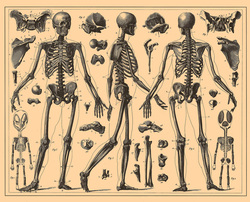Overview of the Human Skeletal System

The skeletal system is made up of 206 bones. It also includes cartilage, tendons and ligaments. There are two, primary divisions of the skeletal system: the axial skeleton and the appendicular skeleton. The primary purpose of the human skeletal system is to provide locomotion, support and protection for the body. Vital organs, such as the brain, heart, and lungs, are protected by the skeletal system. In addition to locomotion, support, and protection, the skeletal system also produces red blood cells, and stores important minerals for the body.
Locomotion
Interaction between the muscular system and the skeletal system allows the bones in the body to move. Muscles are connected to bone by tendons, which are, according to Webster's online dictionary, "tough cord[s] or band[s] of dense, white, fibrous connective tissue". Bones are connected to each other by ligaments, which are, according to Webster's online dictionary, "tough fibrous band[s] of tissue". The point where two bones come together is called a joint. The three major types of joints in the body include: immovable (synarthroses), slightly movable (amphiarthroses) and movable (diarthrosis). An example of an immovable, or synarthroses, joint is the small area in the skull between skull bones. An example of a slightly movable, or amphiarthroses, joint is the area between the ribs and sternum (connected by cartilage). There are six types of movable joints in the body. They include: ball-and-socket, condyloid, gliding, hinge, pivot and saddle.
Protection
The axial skeleton, consisting of the skull, sternum, ribs and vertebral column, is the primary division of the skeleton responsible for protecting vital organs. The skull protects the brain and the vertebral column protects the spinal cord, both vital organs within the nervous system. The sternum and rib cage work together to protect the heart and lungs.
Support
Bones and cartilage are the only two rigid parts of the body. Dense and rigid bones allow for the human body to remain upright, and to maintain it's structure. The skeleton also provides a framework for all other soft tissues (muscle and organs) to attach to.
Production of Red Blood Cells
Bone marrow that is located in certain bone structures produces red blood cells for the body. As red blood cells are worn out and destroyed by the liver, healthy marrow produces, on average, 2.6 million red blood cells per second.
Mineral Storage
Bones store important minerals such as calcium and phosphorous for the body. When the amount of one of these minerals in the blood is too high, it will be stored in the bones. To the contrary, when blood levels of the minerals get too low they are transferred out of the bones back into the blood.
Locomotion
Interaction between the muscular system and the skeletal system allows the bones in the body to move. Muscles are connected to bone by tendons, which are, according to Webster's online dictionary, "tough cord[s] or band[s] of dense, white, fibrous connective tissue". Bones are connected to each other by ligaments, which are, according to Webster's online dictionary, "tough fibrous band[s] of tissue". The point where two bones come together is called a joint. The three major types of joints in the body include: immovable (synarthroses), slightly movable (amphiarthroses) and movable (diarthrosis). An example of an immovable, or synarthroses, joint is the small area in the skull between skull bones. An example of a slightly movable, or amphiarthroses, joint is the area between the ribs and sternum (connected by cartilage). There are six types of movable joints in the body. They include: ball-and-socket, condyloid, gliding, hinge, pivot and saddle.
Protection
The axial skeleton, consisting of the skull, sternum, ribs and vertebral column, is the primary division of the skeleton responsible for protecting vital organs. The skull protects the brain and the vertebral column protects the spinal cord, both vital organs within the nervous system. The sternum and rib cage work together to protect the heart and lungs.
Support
Bones and cartilage are the only two rigid parts of the body. Dense and rigid bones allow for the human body to remain upright, and to maintain it's structure. The skeleton also provides a framework for all other soft tissues (muscle and organs) to attach to.
Production of Red Blood Cells
Bone marrow that is located in certain bone structures produces red blood cells for the body. As red blood cells are worn out and destroyed by the liver, healthy marrow produces, on average, 2.6 million red blood cells per second.
Mineral Storage
Bones store important minerals such as calcium and phosphorous for the body. When the amount of one of these minerals in the blood is too high, it will be stored in the bones. To the contrary, when blood levels of the minerals get too low they are transferred out of the bones back into the blood.
